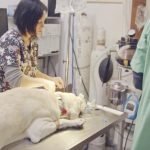Dr. Smolkin discusses spinal manipulative therapy for dogs and cats as well as how this can speed up recovery time. In this video, we explain what spinal manipulative therapy actually is and what it looks like, animals that might benefit from spinal manipulation as well as what conditions it can treat. We also discuss those who are qualified to perform manual therapy; either veterinarians with training in spinal manipulation or human chiropractors with the animal training. Other topics covered include adjustments, subluxations, pain management, spine alignment and more.
TRANSCRIPT:
Hi, I’m Dr. Ilana Smolkin and I’m here for healthcareforpets.com. Today I’m going to talk about chiropractic care or what sometimes is referred to as manual therapy and yes, chiro care can be done on your pets, your cats or dogs.
Chiropractic care is a drug-free way to try and help with pain control for your pet. When a joint becomes restricted in its motion through trauma or stress then that can affect the whole body, that will affect the nerves in the area, the muscles and that leads to pain and sometimes leads to decreased function. The easiest way to think about this is to think about a big joint so think of your wrist for example so it can go obviously back and forth. Sometimes you have issues and your wrist can only go to here (stops bending wrist) and you can’t bend it backwards so what chiropractic care does is help decrease that restriction and help free that so that can move more properly through its normal range.
So the first thing that gets done when you go in to have an assessment with your pet, your practitioner is probably going to want to see your pet walk. They’re going to look for subtle changes in your dog or cat in the way that they move. So is one leg a little bit shorter than the other? Or is there an obvious limp? Is the head-bobbing in a strange direction as they go? From there then they’ll do a few big tests so how far can a dog turn its head left and right? Sometimes we can use treats to do that and actually coax the dog to do that on their own. A little bit harder than with a human because a human you can ask them to make these movements with dogs we have to convince them to do them themselves. Then the practitioner is going to put their hands on the dog or cat themselves and they’re going to feel every specific joint. What we need to realize with the spine is although we think of one joint being the issue, obviously when we turn our spine or have to curve, we have lots and lots of joints all along our spine and all of those need to properly function for us to get that good bend and that good motion. If anything’s restricted, we either have to cheat a little bit so sometimes we’ll turn or cock our head to try and get that motion or have to do another compensation that can lead to pain elsewhere. I used to have shoulder issues and it took a while for someone to figure out that my shoulder issue was a hip issue and all the muscles were being pulled in strange directions to compensate for that hip but where I felt my pain was in the shoulder so it’s important when you go in to have that open mind that your dog might be limping on its right front leg but the chiropractor might concentrate a little bit more on the left hip for example or somewhere else in the body. It’s not always exactly where the pain is coming from that is the area that needs the most attention.
So what are the things that benefit from chiropractic care? I’ve already kind of said the obvious would be a painful animal so someone that’s limping or showing signs of overt pain but think of prevention as well. You have a lot of animals that are very active so all your competition pets, so dogs that are doing agility or any kind of activity or even dogs that just run really hard in the park or run with you maybe you’re a long-distance runner and take your dog along with you. Dogs like to play with each other and sometimes t-bone each other and knock each other out and that can cause some big issues down the road. Urinary incontinence is a great place that a chiropractic care can really help. Urinary incontinence is very common in female dogs. Often thought as a problem with hormones but that’s not the only reason. Sometimes there are imbalances in the pelvis itself that can lead to incontinence or dribbling of urine. My own dog personally was on medication for two years for urinary leaking and after I started getting the training in chiropractic care, I was able to get her off medication and now four years later she is still yet to need it. I would say it has about a 60 to 70 percent success rate with these patients.
It’s also really good to help for animals that are recovering from an injury so maybe they’ve had a surgery and from that surgery they had to limp for a little while. For example, a cruciate tear which is common in dogs and these dogs will need surgery. Unfortunately, chiropractic care is not going to fix a torn ligament but it is going to help fix those imbalances. That leg has been held up for a while, the hips are probably going to be torqued kind of crookedly, the neck might be affected and all of that can help be realigned after surgery to help speed recovery and also help decrease the strain on the other leg which is now at a greater risk of rupturing down the road and so it might save you from a second surgery.
It’s very important to find a practitioner that is properly trained in this. This is something that not everybody should be doing and there is some differences between human and animal anatomy as well as the diseases that can affect their spine and their joints but a human chiropractor can be trained in animal as well as a veterinarian depending on the country and the regulations there.
The best way to find someone who is properly certified on animal chiropractics is to go to look up at one of the colleges to see a registered practitioner. This is the College of Animal Chiropractors, the American Veterinary Chiropractic Association or the International Veterinary Chiropractic Association as well.
This practitioner should work with your regular practitioner to ensure the best care for your pet. Sometimes this practitioner might be your regular practitioner and like myself as someone who’s able to do both regular medicine and chiropractic care but sometimes you go to a different veterinarian for your overall assessments and so those two need to work together so that you get the best care for your pet. It’s important that your veterinarian knows that you’re getting this care and that the chiropractor knows what medications that you’re giving them and what other conditions your pet might have because that could change what adjustments they feel comfortable doing and what areas that they want to do.
Just remember that chiropractic care doesn’t replace regular check-ups with your regular veterinarian and that sometimes animals are painful enough that they require the integration of both regular pain control and chiropractic care to get what’s best for your pet because what’s most important to us is your pet’s health here at healthcareforpets.com.








